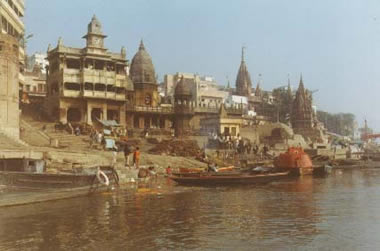![]()
Varanasi: Eternal City of Light
By Daniel C. Peterson and William J. Hamblin
Most religions have sacred cities serving as a focus of spiritual life for the faithful. Among Jews and Christians, Jerusalem often fulfills this function. For Muslims, Mecca is supreme. Such cities tend to be centers of spiritual pilgrimage and religious ritual, as well as sacred learning, culture, arts, and architecture.

In India, with its multitude of gods, there are many such sacred cities. But few can vie with the sanctity of Varanasi (also known in English as Benares). Located on the north bank of the holy Ganges River in the northern Indian province of Uttar Pradesh, the holy city is home to 50,000 Hindu priests (brahmins). Historically, the city has served as a center of Hindu worship and pilgrimage for nearly three thousand years, making it perhaps the oldest continually functioning sacred city in the world. Today Varanasi is the preeminent center of Hindu religious studies, with several important universities and libraries containing over 150,000 rare manuscripts. Sanskrit-the most ancient sacred language of India, with texts dating back to perhaps 1500 BC-is still widely studied and spoken by the thousands of priests and students in Varanasi.
According to legend, Brahma, the head god of the Hindu pantheon and creator of the universe, offered a primordial sacrifice at Varanasi, thereby overcoming the powers of chaos. The great god Shiva was also said to have become incarnate at Varanasi; many of the temples of the city are dedicated to this important Hindu god. In the sixth century B.C., the Buddha visited Varanasi; six miles away at Sarnath he delivered his first sermon after his Enlightenment. Varanasi is also home to two of India‘s great devotional poets, Kabir (1398-1448) and Tulsi Das (1543-1623).
Among the several hundred shrines in Varanasi, the most important is the Visvanath or Golden Temple, dedicated to Shiva. The original medieval building was destroyed in the twelfth century by Muslim invaders, but the temple was rebuilt in 1777 on a magnificent scale, inlaid and plated with over 1500 pounds of gold. The city is also surrounded by a 35-mile sacred road, the Panch Koshi. Devout pilgrims take six days to walk its circuit, visiting numerous shrines, temples, and gardens along the way.
For Hindus, the Ganges is the most sacred river in the world. Ritual bathing in its waters is thought to purify the soul. Among the most remarkable features of Varanasi are the ghats-riverside shrines and temples with pavilions and stairways leading down to facilitate worship in the river. Each day at sunrise, thousands of faithful come to over 100 of these ghats lining the banks of the Ganges. There they descend the stairway into the river to bathe and pray. Throughout the day, vast throngs are constantly visiting the holy Ganges. (The Ganges is also one of the most polluted rivers in the world; ironically cholera microbes cannot survive three hours in its deoxygenated waters.)
Such is the sanctity of the city that faithful Hindus dying in Varanasi are assured of salvation; many elderly Hindus move there to end their days. Varanasi is thus one of the great funerary centers of the world, with many riverside ghats dedicated to Hindu funerals. Tens of thousands are cremated there each year, their ashes scattered in the Ganges, symbolizing the return of the soul to its divine source. Hundreds of funeral pyres burn night and day all along the banks of the Ganges.
Beginning in the twelfth century, Varanasi came under the domination of Muslim conquerors of India-the city thus also boasts a number of magnificent mosques. For several centuries its role as a Hindu sacred center declined, but never disappeared. In the eighteenth century, a great Hindu revival began, restoring its preeminence in Hindu worship. Today, Varanasi is also a home to Hindu nationalistic political movements and is visited by over one million pilgrims annually.
Further reading: Diana Eck, Benares: City of Light (Princeton, 1982).

















